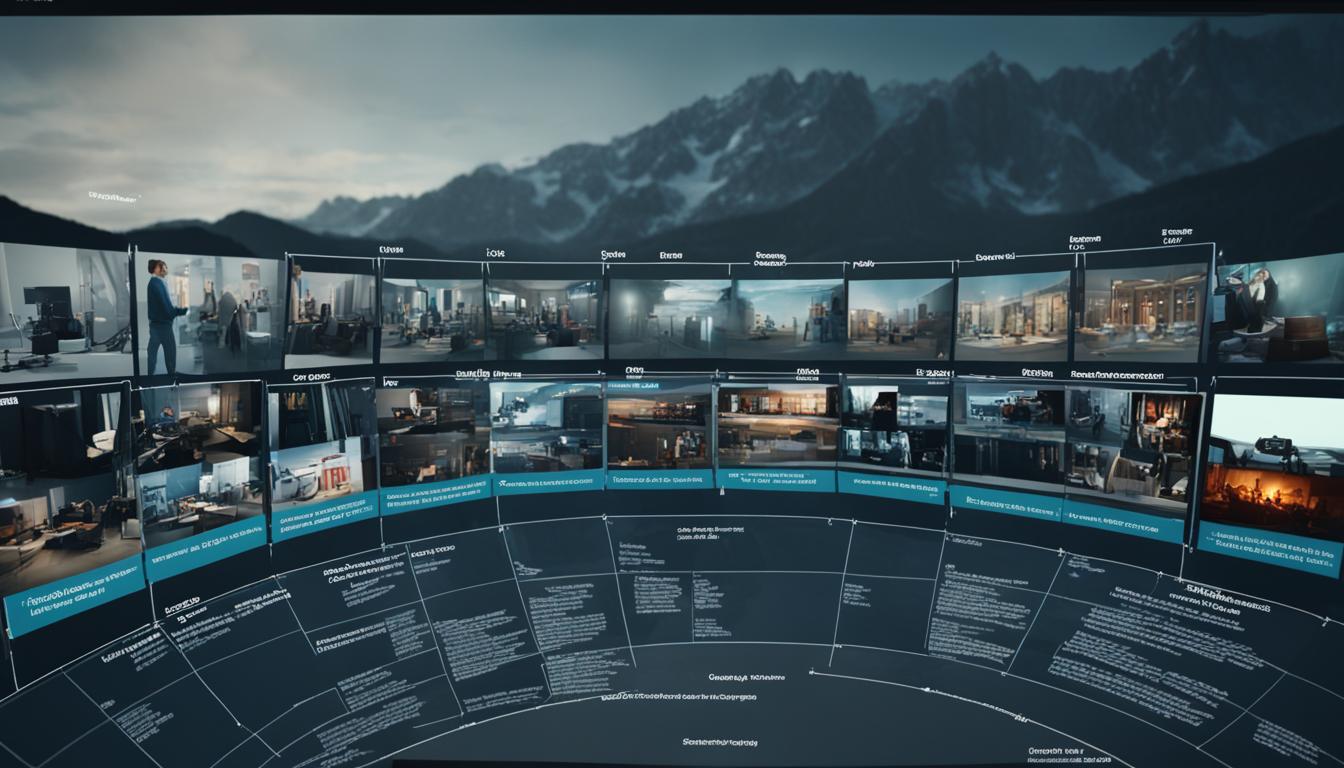The art of cinema is as enthralling as it is intricate, embodying a general description of film production that transcends mere entertainment. Each film’s journey from a mere spark of an idea to the big screen is a testament to the complexity and finesse of the film production process. In South Africa and beyond, the film industry overview reveals an intricate tapestry of roles and stages, each critical in the making of memorable silver screen stories. With a broad filmmaking overview, novices and aficionados alike can appreciate the nuances of movie production stages, gaining insight into the backbone of cinematic storytelling. This guide is designed as an essential making movies guide to demystify the steps and highlight the passion behind the scenes.
In the vibrant and diverse landscape of South Africa’s film industry, understanding these stages is not only beneficial for emerging filmmakers but also for cinema lovers seeking to deepen their appreciation of the art form. Join us as we unravel the meticulous threads that weave the tapestry of film production, from the germinal pre-production planning to the intricate post-production efforts that polish a film to perfection.
Key Takeaways
- A comprehensive understanding of the film production process is crucial for success in the film industry.
- The lifecycle of filmmaking comprises distinct movie production stages, each with its own significance.
- Pre-production, production, and post-production embody the structured chaos inherent in making movies.
- An overview of these stages provides a filmmaking overview that is essential for aspiring filmmakers.
- Awareness of the process enhances the audience’s appreciation of the final cinematic product.
Exploring the Essence of Film Production
The journey of film production is a fascinating harmony of creativity and systematic precision, orchestrating the mutable world of artistic expression within the firm timelines and procedures of the movie-making industry. In this exploration, we delve into the intricate intricacies of developing a film, from the inception of a raw idea to the polished motion picture that graces the silver screen.
The Creative Chaos of Filmmaking
At the core of every film lies a seed—an idea. It’s the creative chaos where this seed is watered through brainstorming and storyboard construction, intertwining the spontaneity of innovation with the necessity for methodical development. The film production process commences with these embryonic concepts sculpted into full narratives, emphasizing the significance of a robust pre-production strategy to translate volatile ideas into stable visual blueprints.
The Linear Journey from Concept to Completion
The film production process is a testament to the art of following a linear journey from concept to completion. This journey is a meticulous celebration of the movie production stages, each playing a pivotal role in crafting a cinematic experience that resonates with and captivates an audience. Crucial aspects such as budgeting, casting, location scouting, and the effective assembly of a dedicated crew converge to create the scaffolding upon which all successful films are built.
Classic Cinema’s Disciplinary Blueprint
Reminiscing on classic cinema provides a venerable blueprint that contemporary film production still follows; a testimony to the dynamism yet disciplined way of making movies. Clinging to a carefully structured film production process, classical cinema showcases the virtue of strategic precision and meticulous resource planning, underscoring the importance of each phase, from pre-production to post-production, in capturing the essence of the filmmaker’s vision.
Indeed, the multifaceted domain of film production is an epitome of an organized tapestry, woven with the threads of creative narratives, systemic planning, and technological advancements, culminating in the art of storytelling through the lens of a camera. Let us continue to appreciate the sweat and pixels that coalesce to form the stories we cherish and the lessons we learn from the reel.
What is the general description of film production?
The film production process is an intricate dance between creativity and meticulous planning. It represents a journey through which a simple story idea becomes a visual and auditory spectacle that can captivate audiences worldwide. This transformation occurs through three distinct stages – pre-production, production, and post-production, each with its own set of objectives, challenges, and milestones. In the realm of filmmaking, whether in Hollywood or the growing South African film industry, understanding these stages is crucial for anyone involved in making movies.
Pre-Production: The Foundation of Film Production
In pre-production, the groundwork for the entire project is laid down. This phase is critical as it involves everything from scripting to budgeting and assembling the right team to translate the conceived story into a viable production plan. The film’s concept is thoroughly evaluated and developed, ensuring that the narrative is strong and the financial underpinnings are secure. Detailed storyboards and shot lists emerge during this stage, preparing everyone for the complex task ahead. Tools such as CamTrackAR can also be employed to pre-visualize scenes, adding to the sophistication of the planning process.
Production: Capturing the Vision on Camera
When the film enters the production stage, the plans laid during pre-production are put into action. Crews converge on locations, and the director leads the charge in capturing pivotal story moments. This phase is characterized by the physical recording of performances, the careful orchestration of lighting and camera work, and the adherence to the predetermined schedules and script. Innovations and adjustments frequently occur on-set to capture the story’s essence, with technology like CamTrackAR assisting in aligning the production with pre-visualized expectations, ensuring efficiency throughout the shooting phase.
Post-Production: Crafting the Final Piece
The culmination of the film production process occurs in post-production, where raw footage is transformed into a polished story ready for the screen. Editors play the pivotal role of piecing together scenes, refining the pacing, and adding layers through sound, music, and visual effects. This phase enhances the emotion and aesthetic of the movie, making critical adjustments that shape the final narrative. It’s a period for review and refinement, where feedback is essential to achieve the best possible version of the film before it is distributed to captivate audiences.
FAQ
What is the general description of film production?
Film production is the process of creating a movie from its initial conception through to the final edited film ready for exhibition. It involves a series of stages, including pre-production (planning and preparation), production (filming), and post-production (editing, sound, and visual effects), all of which are necessary to transform a story into a visual narrative that can be shared with an audience.
Can you provide an overview of the film production process?
The film production process begins with pre-production, where the project is conceptualized, the script is written, and preparations are made for shooting. During production, the film is actually shot according to the plan laid out in pre-production. In post-production, the film is assembled, edited, and refined with additional sound and visual effects until it reaches its final form, ready for distribution and viewing.
What are the key stages in movie production?
The key stages in movie production are pre-production (planning, scripting, casting, and preparation), production (shooting the film), and post-production (editing, adding special effects, color grading, and finishing), followed by the distribution of the completed film to audiences.
How does the film industry approach the making of movies?
The film industry approaches the making of movies as a collaborative process that requires meticulous planning and coordination across various stages. Each stage involves professionals with specific roles, working together to contribute to the overall vision of the film. Budgeting, scheduling, and resource management are also critical factors in ensuring a film is completed successfully and released to the public.
What are the essential elements of pre-production?
Essential elements of pre-production include story development, scriptwriting, casting actors, assembling a crew, selecting locations, planning the production design, budgeting, scheduling, storyboarding, and organizing equipment and logistics for the shoot.
Why is the production phase important in filmmaking?
The production phase is where the visual and audio elements of the film are captured. It’s crucial because it’s the execution of the pre-production plan and the moment when the actors bring the script to life on camera. It requires strict coordination among the cast and crew to ensure the director’s vision is realized.
What happens during the post-production phase?
During the post-production phase, the film is edited to create a coherent narrative. The editor selects the best takes and assembles the film, music is added, and sound is designed and mixed. Visual effects are created and applied, and color grading is used to enhance the visual tone. This phase is essential to refine and enhance the film’s story and aesthetic before it’s released.
What tools and technologies are commonly used in film production?
Common tools and technologies used in film production include cameras and various lenses, lighting equipment, sound recording devices, rigs for camera movement like dollies and gimbals, editing software (like Adobe Premiere Pro or Final Cut Pro), visual effects software (such as After Effects), and color grading tools (like DaVinci Resolve). Technologies such as virtual reality and augmented reality apps, like CamTrackAR, are also increasingly used for pre-visualization and complex shot planning.
How do budget and resources affect film production?
Budget and resources are critical factors in film production, as they determine the scope and scale of a film. They affect everything from the quality of actors and crew that can be hired, the locations where filming can take place, the type and amount of equipment used, and the extent of post-production effects. A well-planned budget ensures that the film can be completed without compromising on its creative vision due to financial restrictions.
What distinguishes classic cinema production processes from independent filmmaking?
Classic cinema production processes typically involve larger budgets, established studios, and a more structured and disciplined approach with pre-defined roles and methods. Independent filmmaking, on the other hand, may have smaller budgets, a more flexible process, and often requires filmmakers to wear multiple hats and be more adaptable to change throughout the production.






